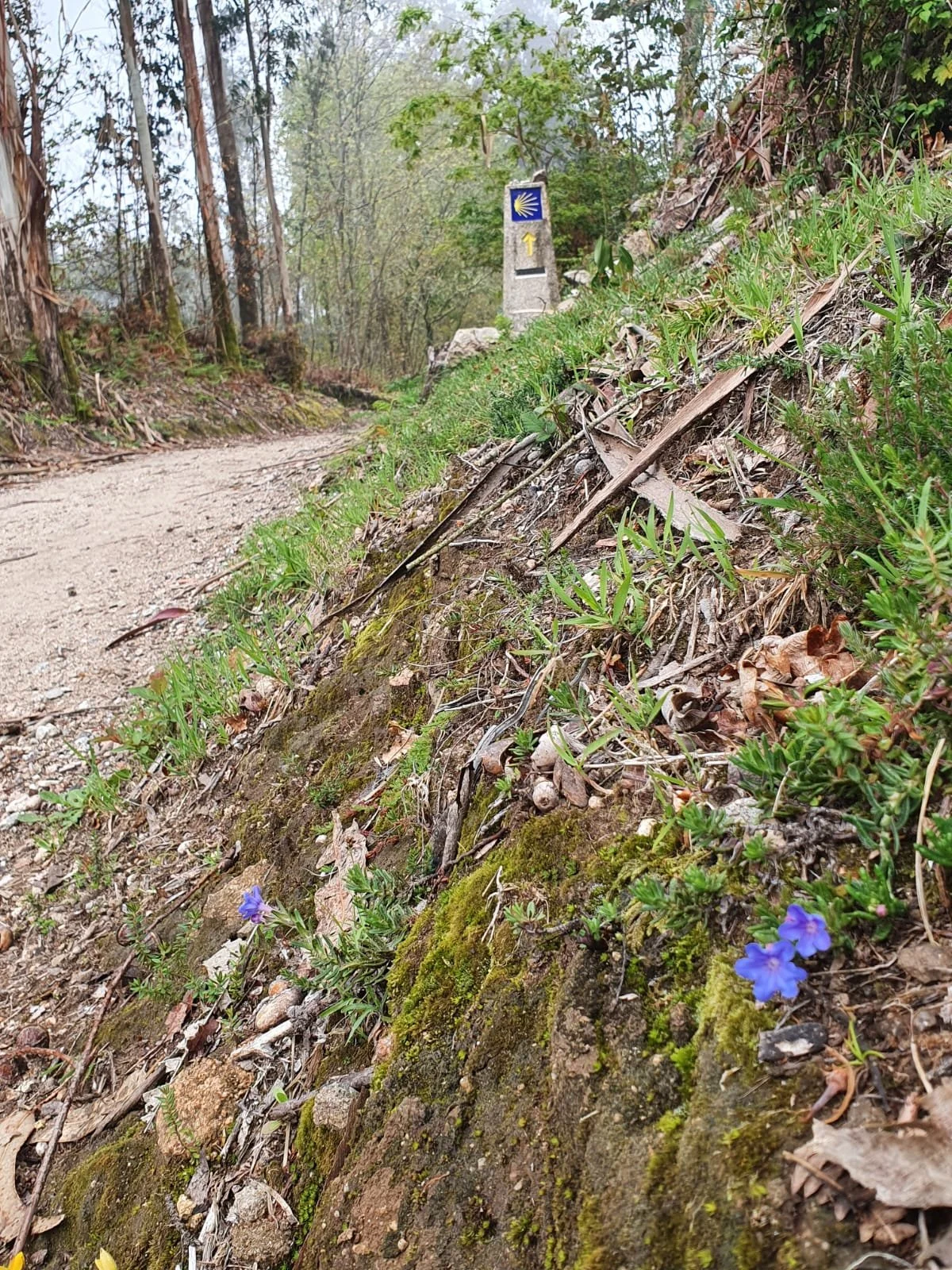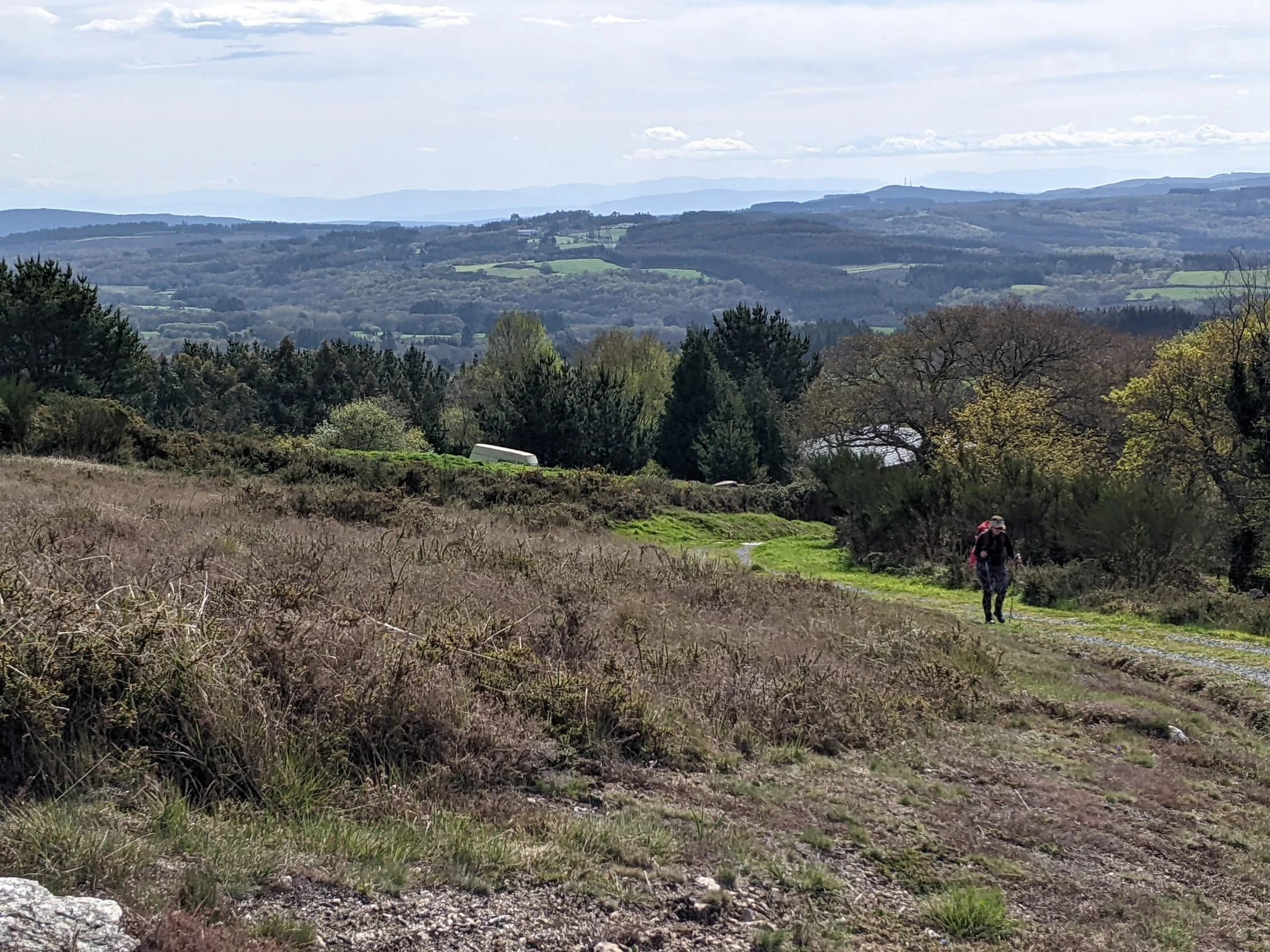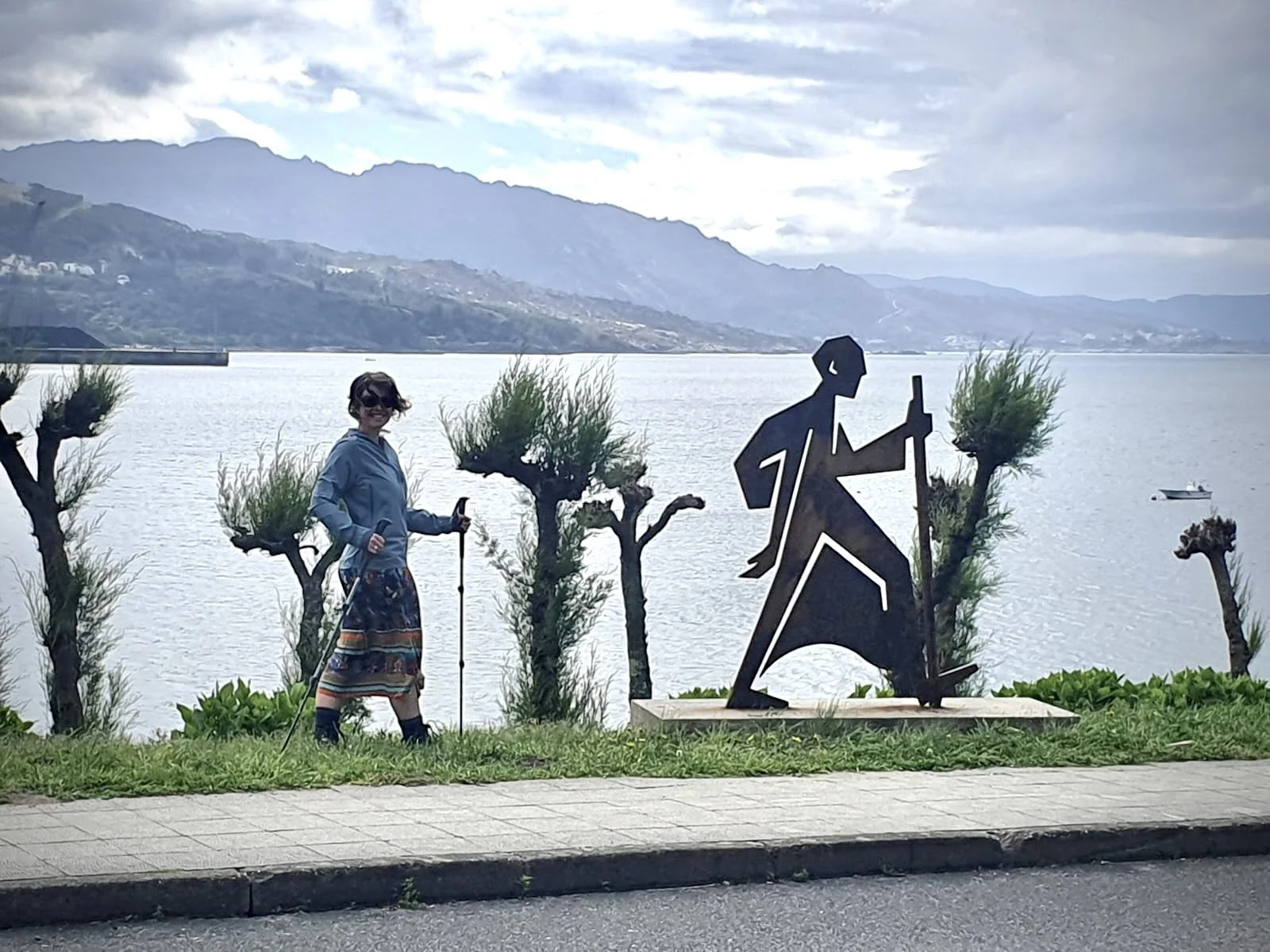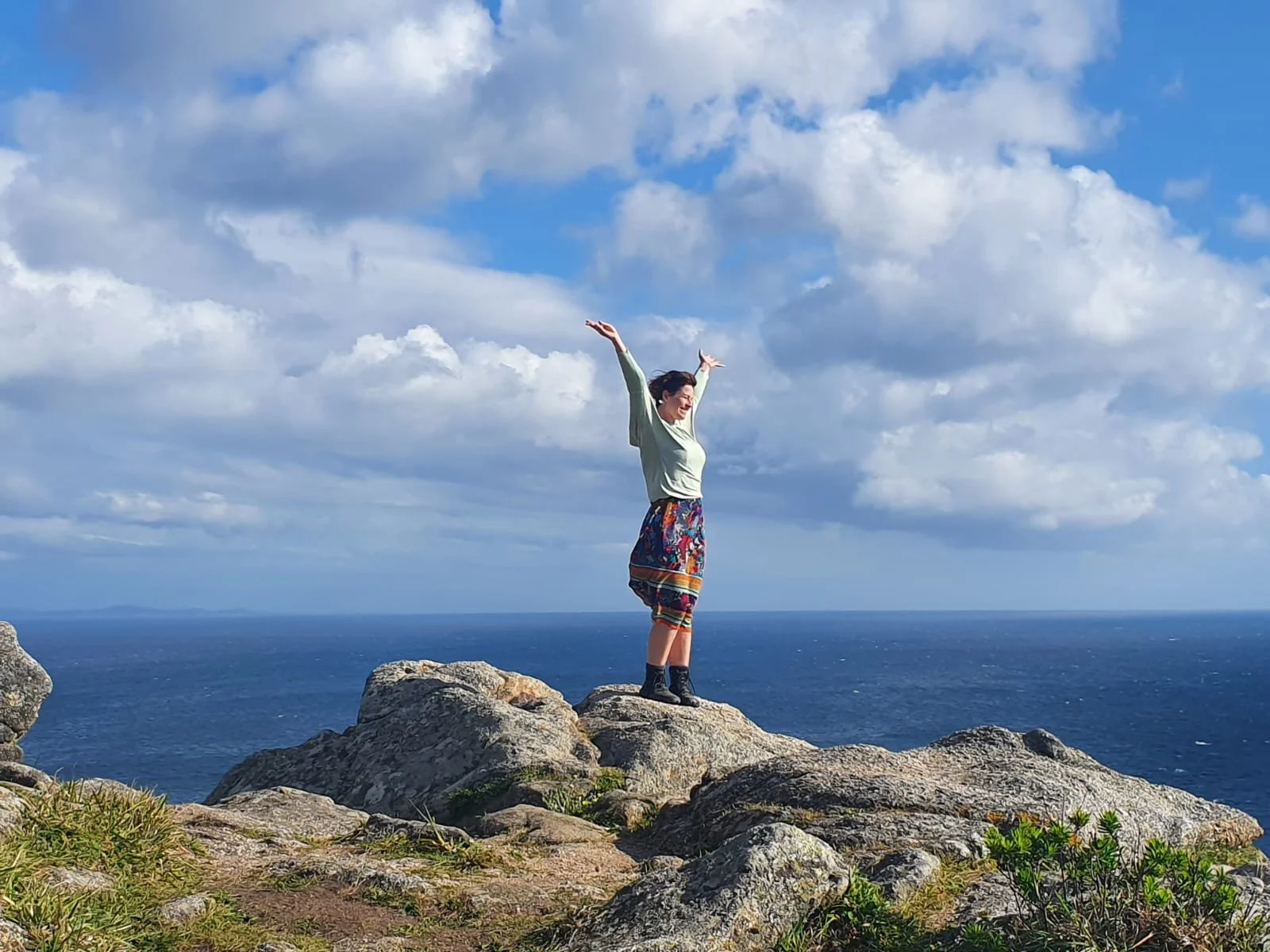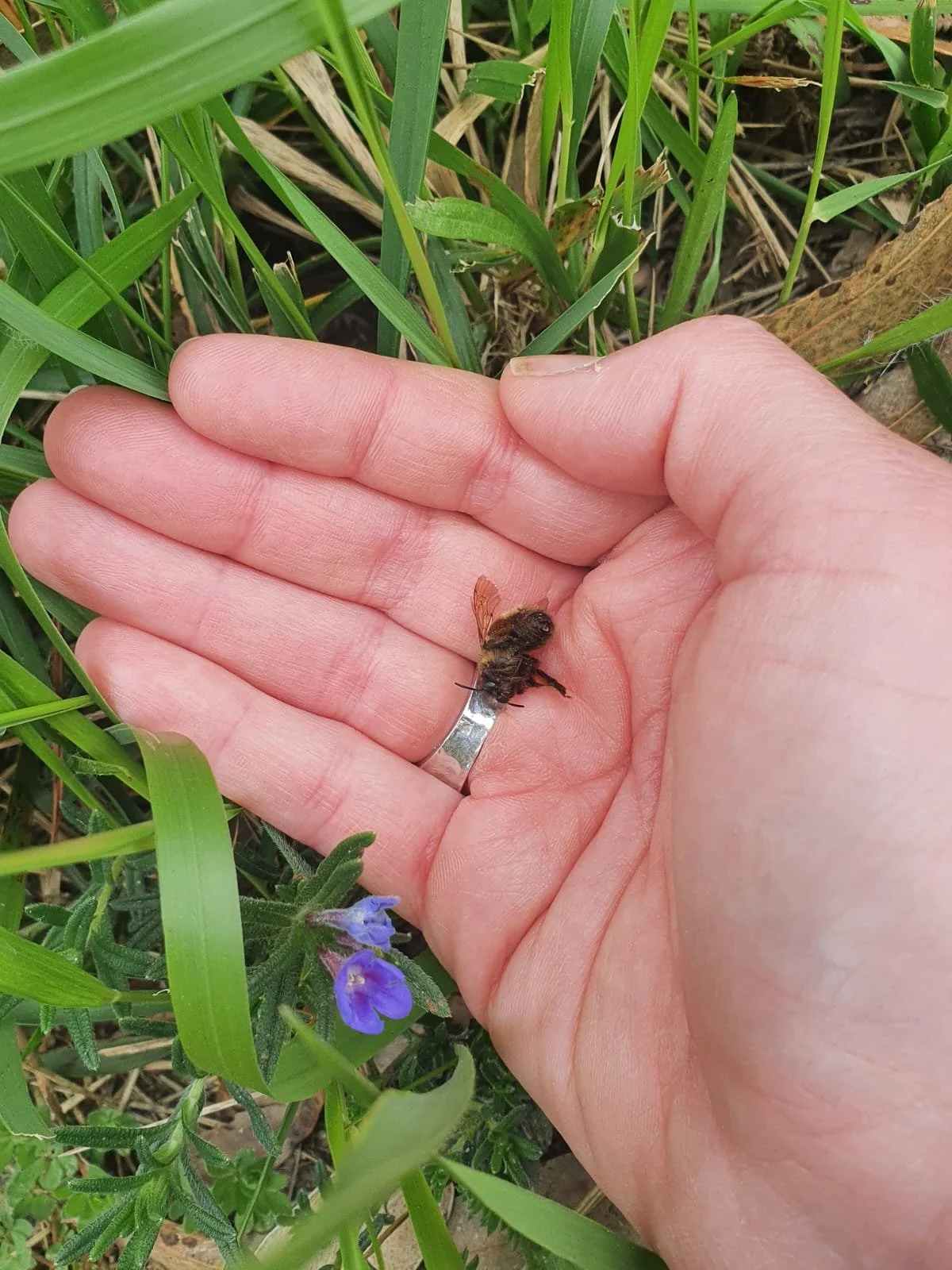On…Pilgrimage
Is it really possible to find joy amid climate sorrow?
Back in April, I walked 200km of the Camino Pilgrimage in Spain as a way of working through my climate sorrow; the rage, the grief, the anxiety, the sense of deep despair... As I travelled deep into what most grieves me about the state of the world- and my participation in that- I also unearthed a profound sense of peace and joy unlike anything I had experienced before. Here I hope to share a little of that experience with you. Enjoy!
Why would someone who loves to avoid pain embark on a journey that would almost certainly involve substantial levels of discomfort?
Over the course of my 10 day camino experience, I gained five enormous blisters, contracted norovirus (more on that later), sprained my hip, walked nearly a whole day without food due to lack of supplies, and had several sleepless nights in shared pilgrim hostels.
The truth is, that since burning out as a climate activist, I have been desperate to find a way to live with my climate sorrow. A way that does not have me running my mind and body into the ground on a regular basis.
My burnout experience was, ironically a roundabout way to avoid pain; I was too scared to stop and feel my fear and grief about climate change, and so I kept on going until I could go now longer.
This was not, in fact, my first burnout experience, and it may not be my last, but I have resolved to do what I can to learn from such a painful experience, and to share what I have learnt with others.
Speaking with a friend about my burnout experience a couple of months ago, he urged me to join a group he was taking to walk the camino.
“Honestly, you’ll love it. I know this is exactly what you need.”
The cost of the Camino is minimal; hostels charge around €10 a night and most restaurants offer a “pilgrims menu” with delicious and plentiful Spanish food at cost price. My starting point - Lugo - is also relatively near to me, a 22 hour train journey.
I had previously heard good things about the camino, so I decided to go for it. I’m game for anything that can offer me some consolation in these daunting times.
The camino has a variety of routes from all over. I took the Camino Primativo from Lugo, to Santiago and then went onto Fisterra on the coast - known as ‘the end of the world’.
The sorrow that I carried with me as I embarked on the camino was not limited to my climate grief. As well as many other interconnected and devestating global events unfolding across the globe, I also carried with me the illness of someone very dear to me, and the uncertainty of what their future holds.
In other words, I felt in a substantial amount of emotional pain. My metaphorical “cup” of personal resilience was feeling rather empty.
The first few steps of the camino were pretty daunting. My pack, carrying everything I needed for the journey, was weighing heavy. I had treated myself to a fancy new pair of shoes in the hope of placating my fragile knees, but I hadn’t worn them in properly and my feet very quickly began talking to me.
The air was cold and misty - so much so that the unusually cold weather had made it onto the local news. I felt climate grief pressing in a little closer.
By the end of the first 16 mile day my feet were pounding. That was when I sat down in the evening sun at our first hostel and wrote to you all a couple of weeks ago - ‘I am here to learn how to find joy in suffering’.
Buen Camino!
One of the things that is most special about the camino is the experience of meeting and walking with other pilgrims.
It is customary to greet fellow passing pilgrims with “buen camino!”, meaning “have a good pilgrimage!” Firm friendships can be easily formed in an afternoon after long hours walking with strangers who open up with the deepest of conversations.
“What brings you to the camino?” I casually asked one passing pilgrim, travelling from Northern Europe.
“A cocaine addiction”, he responded, “this is my rehab.”
The camino, which he had been walking for the past 5 weeks, was apparently the best form of rehab he’d ever had.
I could believe it. Despite the pain, sleeplessness, hunger (and nausea still to come), the camino was working it’s magic on me too.
I noticed how easy it was to listen to others and be listened to; with 10 or more hours of walking stretching out ahead of us, there’s no rush to understand or be understood. We could take our time with each other, get to know each other gently, and focus on each other completely.
Distractions were minimal, nature abundant. We did not even need to check our phones to find our way - every part of the route has multiple way markers with directions and the number of kilometres to the final destination.
The camino has waymarkers throughout, meaning it's possible to walk without having to get a phone or map out the entire way.
The idea of the camino as a metaphor for life’s journey is an obvious one, but what I love about it, is the embodied nature of that metaphor.
It is one thing to work with an image in our mind’s eye, but it is another thing entirely to experience it in our bodies. As my calves trembled and my blisters popped, my mind could be nowhere else but in my body.
In other words, my physical pain actually soothed my mental and emotional pain by relieving me of my overthinking and ruminating tendencies. The more my body hurt, and I found myself able to move through that, the free-er my mind became.
This is different from normal experiences of physical pain, because in this instance, I had chosen it, for the sake of the journey that I knew I wanted to take. It was not something happening to me, so much as something that I was participating in.
It did, however, also make me think of one of my dearest friends who lives with chronic pain, and her remarkable ability to find joy and gratitude in pretty much any situation.
It left me wondering; is there some way in which sorrow actually cultivates joy in some cases and in some way, or perhaps heightens it? And if so, what could this mean for our climate sorrow?
Finding my rhythm
In a Facebook Live I shared in the Self Care for Climate Activists page whilst on the Camino, I talked about how my Camino experience resembled my journey as a climate activist; it mirrored my initial passion and enthusiasm, followed by a series of aches and pains, those moments of thinking I would give up entirely, and then an eventual finding of my rhythm.
Over the course of the Camino, I got to know my capacity better and how to work with myself; at what times, for example, I was better suited to walking, when breaks most helped me, and how to keep myself motivated when struggling.
I feel the same about my new way of approaching activism, since recovering from burnout.
Just as I was really hitting my stride with my longest day yet, however, I came down with norovirus.
A stomach bug whilst staying in a shared dorm after 18 miles of walking would be most people’s idea of a nightmare, however what made this a particularly “special” experience for me is that I have a long standing and very stubborn vomit phobia.
Until this moment, I was fast approaching twenty five years of vomit free living, although it didn’t feel at all freeing.
Every day since I was last sick at seven years old, I have washed my hands extra thoroughly, avoided notoriously contaminated foods, and reduced exposure to potentially contaminating spots such as public toilets or crowded public spaces. Not to mention many, many hours of extended anxiety and nausea when I really needed to allow myself to be sick but couldn’t, or when I was so worried I might be sick that I ended up feeling nauseous.
I have been round and round trying to understand and cure my sick phobia; I know it has to do with my desire to control things and to not let go, for example.
I know that it relates to an early bereavement where being sick somehow got caught up in my young mind with the death of the person I loved. But nothing, not, nothing has loosened the grip that my fear of vomiting has had on me for the best part of two and a half decades.
That was until the Camino when I calmly walked myself to the bathroom and released what I needed to from my body.
On one level, I am certain that sheer exhaustion played a significant role in the peace I experienced as I faced one of my most long standing fears. But there was more too.
Just one week of not knowing where my next meal was coming from, where I would be sleeping, who I would be spending time with, whether I could finish what I had set out to do or where I was going, had expanded my capacity for letting go of control in a way that over a year and a half of therapy since burn out had not facilitated in me.
At the beginning of our Camino journey we were each invited to pick a stone that symbolised a personal burden and to carry it with us to the end of our pilgrimage.
I chose a small granite stone, and it was for me a symbol of the shame I carry about all things in the world I wish I could fix, even though I know they are more often than not out of my control; stubborn imperfections within myself, the suffering of people I love, climate change.
I carried this little rock with me for over 200 kilometres until I reached ‘Fisterra’ meaning ‘the end of the world’ and I hurled it into the sea.
Walking with other pilgrims and hearing of all the sorrows and disappointments of their lives - childlessness, bereavement, illness, unfulfilled dreams - I realised there is nothing to be ashamed of in our weaknesses.
We are taught that these sorrows are so unusual, that they are to be hidden and concealed. That they are a sign we are doing something wrong and if we work hard or smart enough we can plough on through them.
But not a single person I met and spent more than a few minutes talking to was without some kind of significant sorrow. The Camino seemed to give us our honesty back, and with it a greater capacity to heal.
Our vulnerabilities and weaknesses can instead be the places where we learn grace, compassion, perseverance and humility, even if they also leave us wounded. They can be where we learn to lean on and trust others, but only if we can loosen the idea that a joy-filled life is one void of suffering.
It is this realisation that I believe allowed me to be sick when I needed to. And as I did, in that moment of my worst fears and significant physical discomfort, I experienced profound relief and gratitude, even joy. The one and the other were inseparable.
Not easy, but rich living
The relevance to climate sorrow of my overcoming my crippling vomit phobia on the Camino, was for me an increase in my capacity to accept that which I find utterly unacceptable.
Acceptance does not mean giving up— I certainly won’t be inviting any further opportunities to overcome my phobia any time soon— nor does it mean bypassing the sorrow I may feel about what is happening.
Instead, acceptance means for me that I simply give up fighting what is, so that I can conserve my capacity to fight for that which still remains.
It means keeping myself open to what is still open, rather than spiralling into fear or hiding in denial.
The sorrow I encountered on the Camino taught me a great deal about acceptance. I learned that I have a far greater capacity to accept that which I don’t want to accept, and what conditions help me in growing this acceptance (community, nature, and time away from my laptop, for example).
None of us as individuals can control the path that climate change takes, but we can learn how to follow it more faithfully. For sure, it is not an easy path, but one thing the Camino did teach me is that if a path is meaningful to us, if we choose to stick with it because of it’s intrinsic value to who we are, we are much better able to endure its sorrows.
And in this way I learned more about how to bear my climate sorrow; I choose not to turn away from what is happening in the world, sometimes because of guilt or fear, but more often because of the deep love I have for this earth and my desire to be alongside her as we enter this new and uncertain moment in history.
I did not choose climate change, but I do choose to face it, and that in and of itself totally changes my relationship to the fact of what is happening.
That is not at all to say, however, that the Camino helped me in some ways to accept once and for all the dire direction of things as they currently stand. Not at all.
In fact, spending a week immersed in nature only really further connected me with my climate sorrow.
“It’s all here” I found myself thinking, enraged at various moments, “the abundance and beauty and everything we ever really needed. Why have we been taught to trade it all in for empty promises and false securities?”
I noticed in particular, that I passed honey bee after honey bee after honey bee lying dead on the path. Each time I stepped over one I felt a pang of grief and guilt, and fear. That was until I noticed another pilgrim, deep in conversation, tread on one unawares.
A breaking happened inside me, and I felt tears coming.
How do we retain our sense of humanity amidst all that is so inhumane unfolding around us?
So, I made a vow that each dead bee I pass I will pick up out of further harms way and place in the most appropriate nearby spot I can find for them to rest— a flower, or a blade of grass, for example.
It is, of course, more for me than it is for the bee.
And I also wondered if perhaps I shouldn’t. If perhaps more and more people may notice what scientists are dubbing the “insect apocalypse” if these bees are left for others to see. I also wondered if it makes any difference at all.
This is what it means to be connected to climate sorrow. For me at least.
But the other day, something amazing happened.
I was out running and I came across a bee in the middle of the path that I picked up and intended to find a resting place for.
As I hunted around, however, I noticed this bee moved very slightly. She was still alive— barely.
I took her to a dandelion but she was not interested in eating. I took her to some water but she was not interested in drinking. And so I sat with her, on the side of the path, intending to wait until she was gone.
That was until a dog ran up to us shortly followed by their owners, an elderly couple, who asked if I was ok.
I said I was, but that this bee wasn’t doing so good so I was waiting with her.
“Aren’t you scared she’ll sting you?!’ they asked incredulously.
Not at all, I replied. In fact, bees recognise human faces. They are incredibly intelligent, and I have never once been stung by a bee I have tried to help. They seem to know friend and foe very well.
This led to a fascinating conversation; ‘is it right that bees are endangered?’, they asked me. And so I explained— about the biodiversity crisis, and climate change, and our dependence on bees for most of our food chain.
The bee had stopped moving again and as our conversation came to a close we stared at her, together, feeling the weight of it all.
‘At least you tried’ they said to me, as they turned to keep walking. But it was in that moment, as if she had heard us, that this little bee began to move again.
She started making circles round and round on my hand. Then eventually she walked herself all the way up my arm to the highest point of my shoulder.
‘She’s moving, she’s moving!’ they exclaimed to me with child-like excitement, as if the tickling of her feet on my skin wasn’t the only thing I could think of in that moment!
We waited, breath bated, as the little bee gathered her energy. And then she she took off, flying between us before soaring high up into the forest canopy, above us and out of sight.
It was the most joyous and beautiful of experiences!
Joy and sorrow. Inextricably linked. It does not make for easy living, but it certainly makes for richness.



